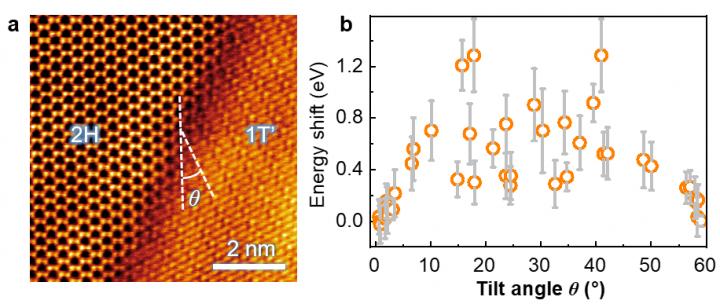A new angle on 2D semiconductors?

Scientists at Peking University use tilt-angle as a knob to tune the interfacial contact properties of 2D semiconductors
Although 2D semiconductor transistors hold a great deal of promise for future nanoelectronics, their applications are limited by the large contact resistance from the Schottky barrier between the deposited metal electrode and 2D semiconductor interface in the short-channel electronics for scaling integrated circuits.
For now, to meet the requirements of ITRS (International Technology Roadmap for Semiconductors) 22-nm-node for the contact resistance, the heterophase engineering (such as 1T/2H-MoS2 and 1T'/2H-MoTe2) that substantially reduces the contact resistance seems to be the only solution. Therefore, in the past a few years, tremendous efforts have been made in the 2D phase engineering to achieve low-resistance contacts with 2D semiconductors for high-performance short-channel devices.
It is well known that the contact properties of such a metal-semiconductor TMDs phase boundaries are determined by their atomic structure, such as the nature of interface bonds and the relative orientation between metallic and semiconducting phases. In order to optimise the interfacial contact properties of 2D semiconductors, it is a prerequisite to understand the correlation between their characteristics and structures.
In a new research article published in the Beijing-based National Science Review, scientists at Peking University revealed the contact characteristics of the 1T'/2H-MoTe2 phase boundary using advanced scanning transmission electron microscopy and electron energy loss spectroscopy (EELS). They found that the contact characteristics of the phase boundary depend on the tilt angles between the metallic and semiconducting phases.
For the phase boundary with a large tilt angle, the plasmon EELS clearly shifts to a lower energy loss, while there is no significant energy change at the phase boundary with a 0° tilt angle (a-b). Their findings indicate that the 0° tilted phase boundary has stronger atomic bonds and better contact performance. The scientists also unraveled the subtle influence of 1T' phase on 2H phase in the two unit cells near the phase boundary.
"The tilt-angle acts as a knob to tune the contact properties," the scientists stated. "Thus, future angle-controlled synthesis technologies may ultimately make short-channel transistors based on 2D heterostructures practical in nanoelectronics."
'Correlating the electronic structures of metallic/semiconducting MoTe2 interface to its atomic structures' by Bo Han et al Natl Sci Rev, 9 April 2020


































